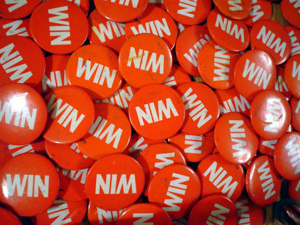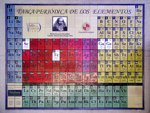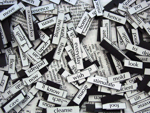 In the past 2 posts, we've looked at the precision of the purely mathematical approach to age guessing, and the skillful approach of estimating age by appearances.
In the past 2 posts, we've looked at the precision of the purely mathematical approach to age guessing, and the skillful approach of estimating age by appearances.
In this post, you'll learn an approach that seems to be a math trick, yet seems impossible to explain in that way.
You starting by asking a spectator to put any 5-, 6-, or 7-digit number in their calculator. You then tell them to multiply that number by 9. The last steps are to add their age to that number, and then show you the resulting number.
You examine the number for a few seconds, and instantly announce their age!
Why this is deceptive
Let's say you perform this, and the resulting number on the calculator is 1,248,695, and you announce that the person's age is 26, which is confirmed by them.Mathematically, all they have is the formula 9x + y = 1,248,695. With two variables, that equation (known to mathematicians as a Diophantine equation) has an infinite number of solutions. How is it possible that you could narrow down the possibilities so quickly, and in your head?
How it works
When you're shown the total, you first add the digits of the answer up in your head. Next, using the age-guessing skills you learned in the previous post, ask yourself if the person could be that age.If the person seems older than that, add 9 to the number you got and ask if that seems to be a more reasonable age. If that doesn't seem right, move up or down in 9-year increments, and keep doing that until you find an age that seems right.
In our example, you'd see the answer 1,248,695, so you add 1+2+4+8+6+9+5=35. Ask yourself if the person could reasonably be 35. Let's say they look younger than that, so you subtract 9. 35 - 9 = 26, so you consider 26, which we'll say seems more reasonable, so you guess that number out loud.
Why it works
You start with a long random number, and then multiply it by 9. What happens when you multiply any number by 9? Square One TV's Nine, Nine, Nine song explains:When you sum up the digits, the result is known as a digit sum. The digit sum of 99 is 18 because 9+9=18. In the video above, notice they keep repeating the process of taking the digit sum until they get a 1-digit number. If you do this, the 1-digit number you get is called the digital root. The digital root of 99 is 9 because 9+9=18, and 1+8=9. The point of the above video, of course, is that any number multiplied by 9 will have a digital root of 9.
What happens when you add a number to a multiple of 9? Let's take 5 as an example. 9+5=14, and the digital root of 14 is 5 (1+4=5). 18+5=23, and the digital root of 23 is 5 (2+3=5), and so on. Let's 18+14, which is a multiple of 9 plus a number with the digital root of 5. 18+14=32, and 32's digital root is 5! Also notice that the answers remain spaced by multiples of 9: 5, 14, 23, 32, and so on. In short, any time you add a number to a multiple of 9, the answer will always have the same digital root as the number you added, and you'll always be a multiple of 9 away from another number with the same digital root.
Applying this to the trick, when you multiply by 9 and add the age, the digit sum (1+2+4+8+6+9+5=35 in our above example) will not necessarily be their age, but will have the same digital root as their age, and be some multiple of 9 away from the correct age (even if that multiple is 0).
Try this out for yourself. Get a calculator, enter any 5-, 6-, or 7-digit number, multiply that by 9, then add your age. Take the result, and enter it into the widget below, then click Submit. A window will pop up showing all the possible ages (listed as the variable a) between 0 and 100 you could be, based on the number you entered.
Sneakier ways of getting to a multiple of 9
If someone is familiar with the effects of multiplying by 9, they might suspect what you're doing. There are other less obvious ways of getting to a multiple of 9:• From a sidebar in in Karl J. Smith's Nature of Mathematics (available at Amazon.com): Mix up the serial number on a dollar bill. You now have two numbers, the original serial number and the mixed-up one. Subtract the smaller from the larger. Assuming you didn't create two identical numbers, the result will have a digital root of 9, because you're subtracting 2 numbers with identical digital roots (More about this principle here).
• Also from the same sidebar in in Karl J. Smith's Nature of Mathematics: Using a calculator keyboard or push-button phone, choose any 3-digit column, row, or diagonal, and arrange these digits in any order. Multiply this number by another [3-digit] row, column, or diagonal. As it happens, most numeric keypads are arranged in such a way that any row, column, or diagonal of the numbers 1-9 will make a multiple of 3. Multiplying two multiples of 3 together will always result in a multiple of 9.
• You could also adapt Scam School's first Pi Day Magic Trick (YouTube link). Have them multiply 1-digit numbers together as shown in the video, until you get to a number somewhere between 1 million and 1 billion. Instead of having them remove a digit as in the original routine, however, have them add their age instead. As you see in the video, though, it is possible to get a number like 8,100,000,000. Adding their age to that would be obvious (assuming the guy in the video is 22, he'd get 8,100,000,022). To prevent this, tell them to avoid pressing the 5 and 0 keys, as this will just result in a lot of zeros at the end (or just one in the case of multiplying by 0).
These aren't the only secret ways to get to a multiple of 9, but are varied and interesting enough to get you started.
If you'd like an age-guessing routine that has the precision of math, but without the appearance of math (or even use of a calculator), I think you'll enjoy the next post, which will be the final installment in our series on how to guess people's ages.





 Back in 2010,
Back in 2010, 




